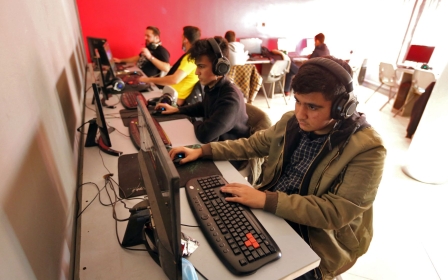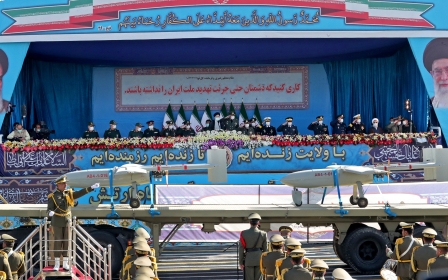Iranian press review: Officials spark anger with 'flood selfies'

Authorities compete over flood photo ops
Iranian officials and conservative legislators have been quick to seize opportunities to exploit last week's devastating floods to implement new public relations campaigns, promoting their status in what local media dubbed "flood selfies".
Monsoon rains caused floods and landslides across Iran, leaving at least 90 people dead and eight unaccounted for.
As news about casualties first emerged, videos and photos of officials visiting flood-hit regions were published on social media and official outlets. The photos backfired, however, with Iranians accusing the authorities of taking advantage of the situation to "show off", despite their failure to control the flood.
Alireza Zakani, Tehran’s mayor and member of the Islamic Revolutionary Guard Corps (IRGC), was at the centre of criticism and mockery, after photos appeared of him touring the flood-hit Emamzadeh Davoud village in the north of the capital.
Zakani, in a blue suit, can be seen in one photo standing on the street in muddy water, speaking to people. The mayor's office also published pictures of Zakani after he had returned to his office in his muddied trousers and shoes.
Mocking Zakani's presence in Emamzadeh Davoud, the Donya-e Eqtesad daily wrote: "After the flood subsided, Tehran’s mayor, in a suit and with a photographer, went there, walked around a bit in the mud, gave some orders, and at every second a photo of him was taken."
Mirza Ali Ayatollahi, an adviser to former presidents, lambasted Zakani and wrote: “A mayor is obligated to find a solution to reduce the impacts of rainfalls, earthquakes and other [natural] incidents; [standing] in the middle of the mud, after the incident, is not his duty."
Meanwhile, the dailies run by President Ebrahim Raisi's administration and the Tehran municipality hailed Zakani’s move, and that of other officials, during last week's flood.
However, even the IRGC-affiliated Javan daily attacked the authorities. Under the headline "The flood's slap", the newspaper wrote: "The officials' only reaction [to floods] was to go where it had happened, and to take some photos in muddy clothes… and this, of course, had no result other than sparking public anger."
Hijab scrutiny a 'distraction' from economic crisis
Shahr-Bano Amani, a former reformist lawmaker, told the Etemad daily that the current strict implementation of the hijab law in Iran has been carried out to divert public attention from the economic crisis.
"The escalating confrontation between women and Gasht-e Ershad aims at pushing the government's economic mistakes out of the spotlight," she was quoted as saying, using the official term for Iran's Islamic Morality police.
"When the criticisms increased over the government's economic policies, and the government realised they had made wrong decisions, they needed another topic to divert [people's] attention.”
In May, Ebrahim Raisi's administration announced a new economic strategy called "economic surgery", which cut wheat subsidies. The new policy led to a sharp increase in the prices of other essential goods and prompted protests across the country.
The unrest was followed by a heavy deployment of Islamic Morality police in Tehran, which fuelled social anger and deepened the socio-political divide in the country.
Iranian sociologists and experts warned that, under the current social pressures, the pretext of implementing the hijab law would cause further social disappointment and polarisation in the country.
"[These actions] will add to the social crisis and hold back the public sphere from stability and comfort. … In Iran's contemporary history, the topics related to women's affairs have always been politicised," Amani said.
Iran trades safety for low prices in car imports
After months of discussing the legalisation of car imports to Iran, the finance website Tejarat News revealed that the government firms and offices behind this push now plan to import vehicles with the lowest price tags, which have been rated as unsafe.
The website reported that the government would allow cars that cost less than $10,000 to be imported to the country, with a VAT rate of 20 percent.
Tejarat News published a chart of foreign manufacturers and their products that Iran is set to purchase. Indian and Chinese companies are at the top of the list, with Renault Kwid India and MVM 110 appearing to be the first two choices of the authorities in Tehran.
According to the report, these two products have earned zero safety stars based on an international car safety rating.
Maruti Suzuki Alto and Hyundai i10 are other products that Raisi's administration is planning to import.
In 2017, former president Hassan Rouhani's administration banned the import of cars as a measure against the US economic war on Iran. Since then, each Iranian citizen has been permitted to import one car annually, with a 100 percent import tax. This policy had resulted in a sharp increase in the price of substandard domestic cars.
When Raisi took office last August, his ministers and supporters in Iran's parliament proposed plans to remove the ban on car imports under the pretext of halting the domestic production of unsafe cars.
Considering the authorities' monopoly over manufacturing and importing automobiles, Tejarat News argued that the recent import legalisation would only add to the government corruption in Iran's car market.
"At first glance, forcing domestic manufacturers to increase the quality or reduce the price of their products seemed to be the main goal to lift the ban on importing cars," Tejarat News wrote. "However, now it seems that the imported cars will not have any better quality than the domestic products.”
*Iranian press review is a digest of news reports not independently verified as accurate by Middle East Eye.
Middle East Eye propose une couverture et une analyse indépendantes et incomparables du Moyen-Orient, de l’Afrique du Nord et d’autres régions du monde. Pour en savoir plus sur la reprise de ce contenu et les frais qui s’appliquent, veuillez remplir ce formulaire [en anglais]. Pour en savoir plus sur MEE, cliquez ici [en anglais].






